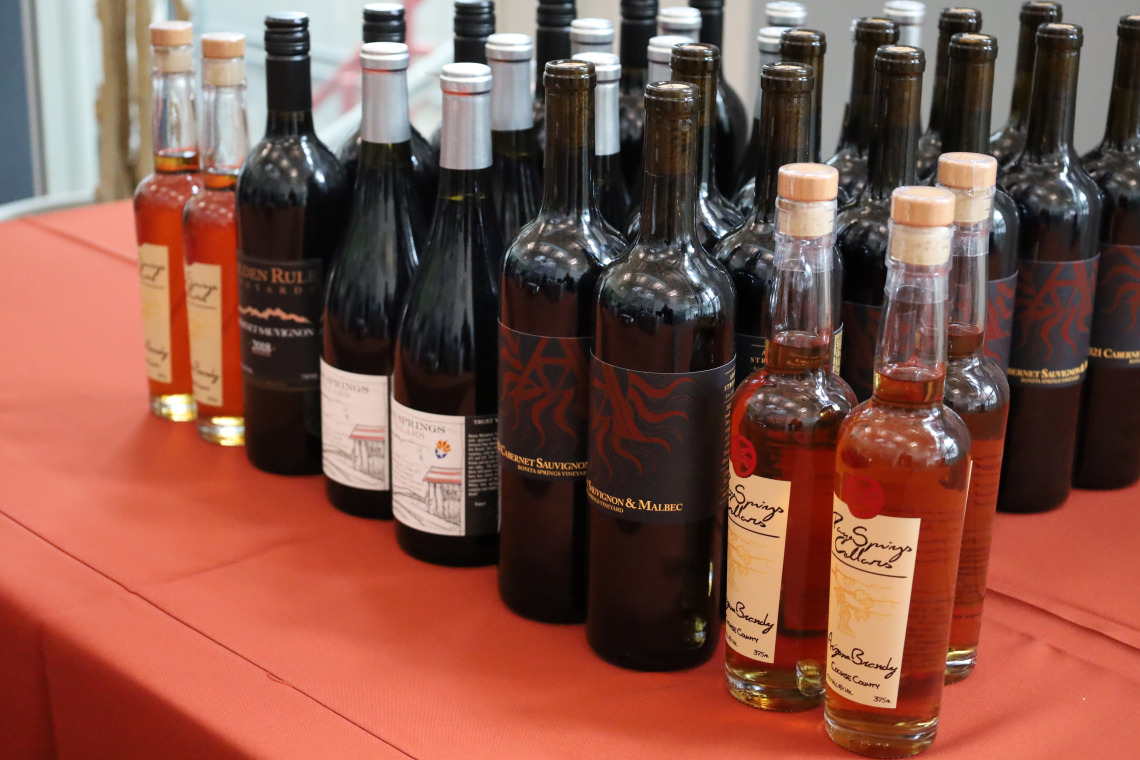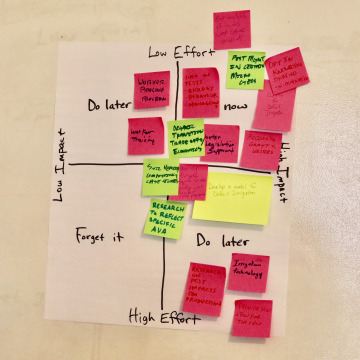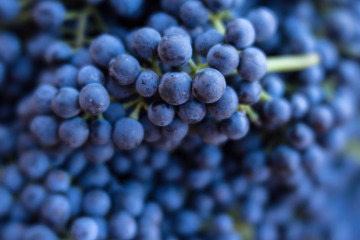University of Arizona Laying Groundwork to Support Wine Industry with Science
At a recent industry summit, Cooperative Extension, growers, and other wine industry respresentatives explored ways UArizona can support the more than 120 producers statewide.

Arizona's vintners offered tastings of their wines and brandy at a recent Biosphere 2 summit. Industry stakeholders hope to craft a collective strategy.
Brad Poole
A recent gathering at Biosphere 2 could lay the foundation for a rich collaboration among Arizona grape growers, wine producers, and University of Arizona Cooperative Extension.
The two-day Viticulture Planning Summit drew industry stakeholders from across the state to hear and talk about how Extension can help them grow better grapes, produce better wine, and build a robust industry.
“This opens up an opportunity for Cooperative Extension and the university to support the Arizona grape growers,” said Matthew Halldorson, Extension’s Yavapai County director and a former grape grower in Washington. Halldorson, climate specialist and Associate in Extension Jeremy Weiss, and horticulturist and Area Associate Agent Joshua Sherman planned the event with a specialty crop grant from the U.S. Department of Agriculture.
“I will not pretend to be the expert on Arizona viticulture. I’ve never grown one grape in Arizona, but I hope that in the same vein that Extension was so important to me when I was a grower, I can deliver some of that back to the growers of Arizona,” he said.
Rich History
The history of winemaking in Arizona can be traced back to European settlers, who brought grapes from Europe, mostly for use in Catholic mass. They established vineyards in Mexico, then brought viticulture as they moved north, said Erik Berg, a Phoenix historian who authored a Journal of Arizona History article “Equal Age for Age: The Growth, Death, and Rebirth of an Arizona Wine Industry, 1700–2000.”

Arizona wine industry representatives brainstormed recently to identify ways University of Arizona researchers can help them continue to build their businesses.
Brad Poole
There are reports of grape growing south of Tucson along the Santa Cruz River in the 1600s, but no reports of winemaking. Because there were grapes, Berg assumes there was small-scale wine production then, but he estimates that the first wine produced in any volume in Arizona was made either by Jesuits or settlers near Tucson sometime after 1780, he told the viticulture gathering.
Missions in Texas and California expanded in the late 1700s, producing hundreds of thousands of gallons of wine and brandy for trade across the Southwest, Berg said.
Today more than two-thirds of American wine comes from California, which produced 600 million of the 752 million gallons produced in 2022. Arizona producers pumped out just 405,000 gallons, according to the U.S. Alcohol and Tobacco Tax and Trade Bureau.
But the industry here is growing.
Between 1999 and 2019, the number of wine producers in Arizona rose from 12 to 125, and from 2012-17 the acreage of grapes rose from 942 to 1,500. The total contribution of Arizona’s wine industry to the state economy in 2019 was $133 million in sales and $68.7 million in gross state product, according to a report produce by Cooperative Extension and university Department of Agricultural and Resource Economics.
The Arizona wine industry is actually three industries, said Dari Duval, co-author of the analysis with fellow economic impact analyst Ashley Bickel and Extension Specialist George Frisvold.
“It’s a cluster of industries. It’s an agricultural industry, the vineyards; it’s a manufacturing industry, wine production; and it’s a retail and wholesale industry, as well,” Duval said.
Forging a Common Defense
Arizona has three American Viticulture Areas, which are designated growing areas with distinct characteristics, according to the Tax and Trade Bureau.
The Verde Valley AVA stretches from Clarksdale to Camp Verde along state Highway 260 east of Prescott. The Sonoita AVA straddles the intersection of southern Arizona’s Pima, Cochise, and Santa Cruz counties just west of Sierra Vista. The Willcox AVA goes from Sulphur Springs Valley on the Willcox Playa northward across Interstate 10 into Aranaipa Valley.
Halldorson recently completed a needs assessment survey among industry stakeholders – the first step in crafting a collective strategy.
Extension science can help grape growers decide how and when to fight pests and diseases – ways Extension helps other farmers who grow lettuce, alfalfa, and other crops. That type of support, such as pest management bulletins, is lacking in the Arizona wine industry, Halldorson said.
Despite competition, there is room for the type of collaboration Extension can facilitate, said Eric Glomski, founder and general manager at Page Springs Cellars, which produces 20,000 gallons of wine annually in Cornville.

D.A. Ranch Estate Vineyards in the Verde Valley produced these Syrah grapes. The vineyard is one of more than 120 wine producers in Arizona.
“The things we’re trying to overcome are more collective than individual. We need to grow better grapes in this state, which is, to me, what this conference is all about. If we don’t attack that as an industry rather than as individuals, I just think it’s going to take so much longer,” Glomski said.
Extension economic analysis can help illustrate the value of the industry, which can help growers and producers convince state legislators to pass laws that help growers and winery operators, he said.
Summit presentation and break-out session topics included viticulture production, economic development, climate tools for operation management, brand development, and technology integration. The summit gave organizers feedback Extension can use to meet industry needs, said Sherman, who has since left Extension.
“What came out at the top was science-based information specific to Arizona. It is an arid wine grape-growing climate, and they need more information that’s related to that, not from California, not from Washington, not from Oregon,” Sherman said.
Growing conditions differ even within the state. A wine produced from a Syrah grape grown in Sonoita will taste different from one grown in Verde Valley, he said.
Sherman secured funding for the summit before the Covid-19 pandemic, which delayed the gathering. They waited, because gathering in person was important to building relationships, which can foster collaboration, he said.
Collective effort is vital to the industry, because many grants from the U.S. Department of Agriculture require it. Without the collaborative infrastructure, many grants are out of reach for Extension researchers hoping to study grapes, said Valerie Rauluk, founder and CEO of the economic development consulting firm Venture Catalyst Inc.
“You have to have a collaboration. You have to have the producers, the university, and the people who supply that ecosystem all working together,” Rauluk said.
Knowledge transfer
Efforts to help the wine industry are an apt expression of Extension’s deepest purpose – transmitting knowledge, said Ethan Orr, Extension associate director for Agriculture and Natural Resources.
“Every time we expand what that knowledge is and who gets that knowledge, we get a massive return in benefits. Our job is to make you more productive, and my job is to listen to you and say, ‘How do we do that?” Orr told the gathering.
Extension hosted the event with Visit Southern Arizona Inc. and Designing Arizona Signatures. In the coming months, stakeholders will work together to craft a strategic plan for the state wine industry.
